
by Kate S. Zalzal Thursday, June 1, 2017
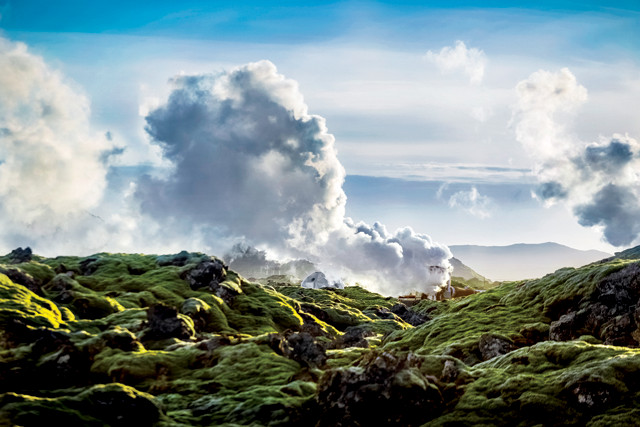
Hellisheidi Geothermal Power Plant, located in southwest Iceland, produces electricity and hot water from the Hengill Central Volcano. Credit: Gunnar Svanberg.
Blocky, moss-covered basalt covers the ground surrounding Iceland’s Hellisheidi Geothermal Power Plant. As acidic rainwater percolates through the landscape, the volcanic rocks slowly dissolve. Some of what dissolves from the rocks — ions of calcium, iron and magnesium — reacts with carbon dioxide in the air to form carbonate minerals. Over thousands of years, these minerals are buried, locking the greenhouse gas underground — and out of the atmosphere — in a persistent, but slow, part of the global carbon cycle.
Deep belowground at the power plant, scientists have created and are deploying an accelerated version of this natural weathering and precipitation process: They are injecting carbon dioxide straight into the subsurface where it rapidly reacts with basalt. Results from their efforts, published last year in Science, show that the injected carbon dioxide mineralizes into solid form in less than two years, effectively achieving the same end that nature does in only a fraction of the time.
The project, called CarbFix, is unique. A partnership of the University of Iceland, CNRS (National Center for Scientific Research in Toulouse, France), Columbia University and Reykjavík Energy, CarbFix is the only active carbon capture and storage (CCS) project in the world that stores mineralized carbon dioxide in basalt. A similar project, sponsored by the U.S. Department of Energy and the Big Sky Regional Carbon Partnership called the Wallula Basalt Pilot Project, recently wrapped up analysis of field tests in eastern Washington. Results from both of these projects have been positive, and offer a promising new, and safe, tool in the effort to combat climate change.
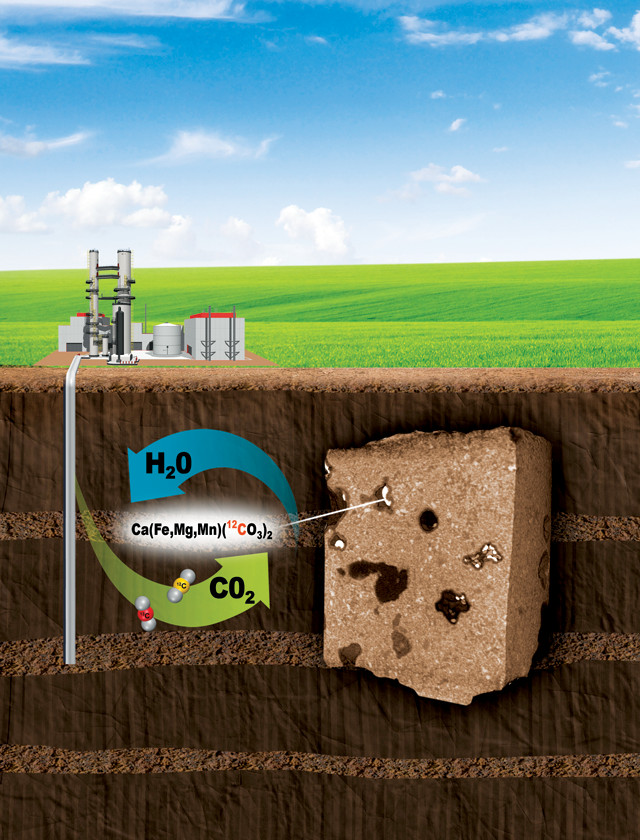
At test sites of the Wallula Basalt Pilot Project in Washington state and CarbFix in Iceland, carbon dioxide was injected underground where it reacted with basalt and water to form carbonate minerals, thus storing the carbon dioxide permanently underground. CarbFix operations have continued and expanded after the successful test project. Credit: American Chemical Society, Environmental Science and Technology Letters/Pacific Northwest National Laboratory.
The breakthroughs in CCS technology presented by CarbFix and Wallula come at a decisive moment. In its 2014 Fifth Assessment Report, the Intergovernmental Panel on Climate Change (IPCC) pegged the amount remaining in the world’s “carbon budget” at 1 trillion tons of carbon. The budget represents the maximum amount of carbon that can be emitted to the atmosphere if global temperature rise is to be limited to 2 degrees Celsius above preindustrial levels — a target that climate scientists say would help avert the most dangerous impacts from climate change. This 2-degrees-Celsius target was the guiding objective at the 2015 United Nations Climate Change Conference, COP 21, in Paris.
Recent IPCC and International Energy Agency (IEA) reports map out future emissions reduction pathways that hypothetically achieve the 2-degrees-Celsius limit, along with the pathways’ associated costs. Components of these scenarios include increases in renewable energy consumption (including nuclear energy), improvements in energy efficiency, fuel switching and CCS — mitigation tools that Peter McGrail, a scientist at Pacific Northwest National Laboratory and principle investigator on the Wallula Basalt Pilot Project, calls “arrows in a quiver.” Without CCS in the quiver, the IPCC estimates that the cost of climate change mitigation will jump 138 percent relative to the expense with CCS included. “Everything that comes out of economic analyses, in terms of the cost to hit a particular emissions target, indicates that having CCS in the technology mix is the lowest-cost route,” McGrail says.
Beyond costs, CCS is also a necessary part of climate change mitigation strategies for other reasons, says David Reiner, assistant director of the Energy Policy Research Group in Cambridge University’s Judge Business School in England. “According to many of the emissions model scenarios, it may be impossible to limit warming to 2 degrees Celsius without CCS in the mix,” Reiner says. Renewables can replace some uses of fossil fuel energy sources, but “it’s more difficult to decarbonize industry,” he says. “That’s why CCS is so important.”
However, only a handful of CCS projects have gotten off the ground in the past decade, a problem the IEA says needs to be “urgently addressed.” There are currently about 15 to 20 large-scale CCS projects in operation globally. Most of these involve the injection of compressed, liquefied carbon dioxide into sedimentary basins, coal beds, depleted oil and gas reservoirs, or saline reservoirs.
For example, the Sleipner Carbon Dioxide Storage Project, a pioneer in carbon storage, has been storing carbon dioxide from a natural gas processing facility in a clay-capped underground formation off the coast of Norway for more than 20 years. Other recent projects include the Boundary Dam Project in Saskatchewan, Canada, the first large-scale coal-fired power plant to apply CCS; the Petra Nova Carbon Capture Project in Texas, which pumps carbon dioxide captured from a coal-fired power plant into oilfields to enhance oil recovery; the Kemper County project in Mississippi, which captures carbon dioxide during lignite gasification, also to aid in oil and gas recovery; and the Shell Quest CCS project, which stores carbon dioxide from oil sands development in a deep saline formation in Alberta, Canada.
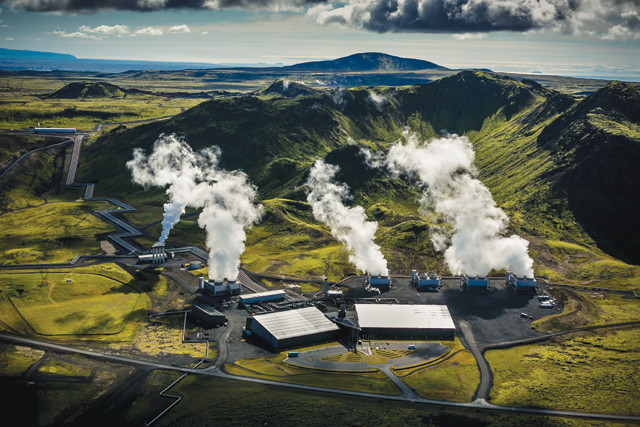
Because Iceland produces and uses abundant amounts of geothermal energy, the country already has relatively low greenhouse gas emissions. However, geothermal energy production results in other emissions, including hydrogen sulfide, which is also injected underground at the Hellisheidi Geothermal Power Plant, where it mineralizes into pyrite. Credit: Árni Saeberg.
Together, these and other projects around the world have the capacity to capture up to 28 million tons of carbon per year, according to the Global Carbon Capture and Storage Institute. But, at just 1 percent of what has to be stored annually in order to total 80 billion tons by 2050 — the benchmark for keeping the global temperature increase to less than 2 degrees Celsius, according to the IEA — that’s a mere drop in the bucket.
High costs of gas capture, technological challenges associated with carbon dioxide injection and underground storage capacity, safety concerns about carbon dioxide leakage, and regulatory uncertainty have slowed CCS deployment worldwide. But CarbFix and the Wallula Basalt Pilot Project are helping answer many of the tough questions that have plagued CCS, particularly regarding the safety and permanence of carbon dioxide storage.
CarbFix is the brainchild of geochemist Wallace Broecker, a climatologist at Columbia’s Lamont-Doherty Earth Observatory who saw an opportunity in Iceland’s geology. Basalt is highly reactive compared to most bedrock, and it contains critical elements needed to form carbonate minerals, such as calcium, iron and magnesium. Additionally, basalt is common, covering 5 to 10 percent of continental surfaces, most of the ocean floor, and nearly all of Iceland. Scientists already knew that weathering of basaltic rocks naturally draws down atmospheric carbon dioxide through the precipitation and subsequent burial of carbonate minerals. They also knew the process was even more intense in geothermal systems because of the flux of carbon dioxide from the magma below. Broecker asked: Could this process be sped up?
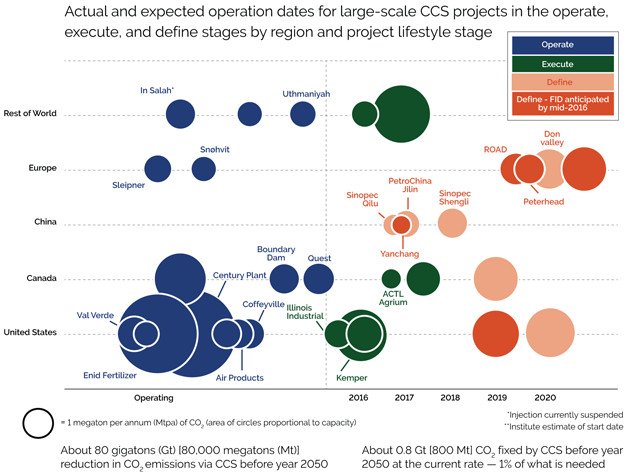
Approximately 20 carbon capture and storage (CCS) projects are in operation globally, a small fraction of what is needed to address climate change according to the Intergovernmental Panel on Climate Change and the International Energy Agency. Credit: Global CCS Institute.
In 2005, Broecker was invited by Iceland’s president Ólafur Ragnar Grímsson to give a talk on global warming at the University of Iceland. Grímsson wanted to push Iceland toward carbon neutrality and reduce emissions from Iceland’s geothermal plants and aluminum smelters. At the same time, a workshop was held bringing together scientists from the U.S., mainland Europe and Iceland along with Icelandic power companies and industry to explore carbon storage options. Reykjavík Energy offered up injection and monitoring wells at its Hellisheidi Geothermal Power Plant as well as access to water and carbon dioxide produced during the plant’s operations. By 2007, CarbFix had its name, a field site and a team of scientists on board. The project was up and running.

Petra Nova, in Houston, Texas, is the largest installed carbon capture project on an existing power plant in the world. Begun in 2016, it sequesters 1.6 million tons of carbon dioxide per year. Credit: NRG.
The team began by developing laboratory experiments and models that could test the thermodynamics and reaction rates of subsurface carbon mineralization. They knew early on that Iceland’s unique geology would challenge conventional carbon storage methods, which rely on overlying impermeable cap rock layers to structurally trap liquefied carbon dioxide in the reservoir rocks into which it is injected. Over time, the carbon dioxide dissolves into pore waters and loses its buoyancy so that it can no longer escape to the surface, but this process can take hundreds to thousands of years. Little carbon mineralization happens at most of these sedimentary basin sites and long-term monitoring is necessary to ensure that the carbon dioxide doesn’t leak out of the ground. Iceland’s basalts, however, have no cap rocks and are relatively young and full of cracks and fissures, having erupted from the Mid-Atlantic Ridge over the last 15 million to 18 million years. Thus, carbon dioxide could easily escape before it could react with the basalts and mineralize.
So, CarbFix researchers had to get creative, says Juerg Matter, a geoengineer at the University of Southampton in England who has been involved with the project since its inception. “We developed a unique injection system that allows us to co-inject water with the gaseous carbon dioxide,” he says. In this system, water and carbon dioxide are pumped into the injection well from different pipes, mixing partway down the well and forming carbon dioxide-saturated water — essentially sparkling water. The continuous flow of water down the well contains the carbon dioxide, preventing it from escaping during injection and mitigating its buoyancy once in the basalt reservoir.
In geothermal power generation, wells are drilled into magma-heated, pressurized water reservoirs belowground. As the water nears the surface, the pressure drop causes it to boil and turn to steam, which is used to turn turbines and generate electricity. Hellisheidi also produces a hot water supply for Iceland’s capital city, Reykjavík. Along with the valuable water and steam, the process also brings carbon dioxide and hydrogen sulfide — a noxious gas that under Icelandic law must also be controlled — to the surface.
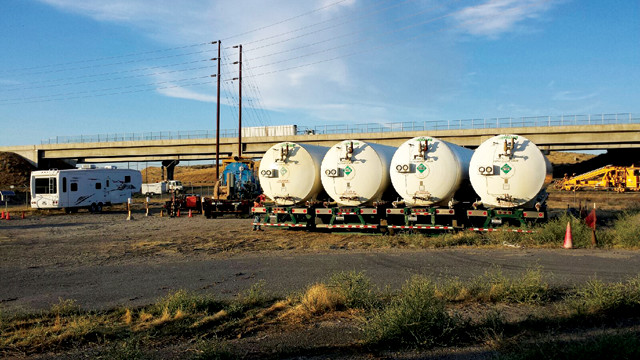
Tanks hold carbon dioxide before it is injected underground at the Wallula Basalt Pilot Project site. Credit: Boise Inc./Pacific Northwest National Laboratory.
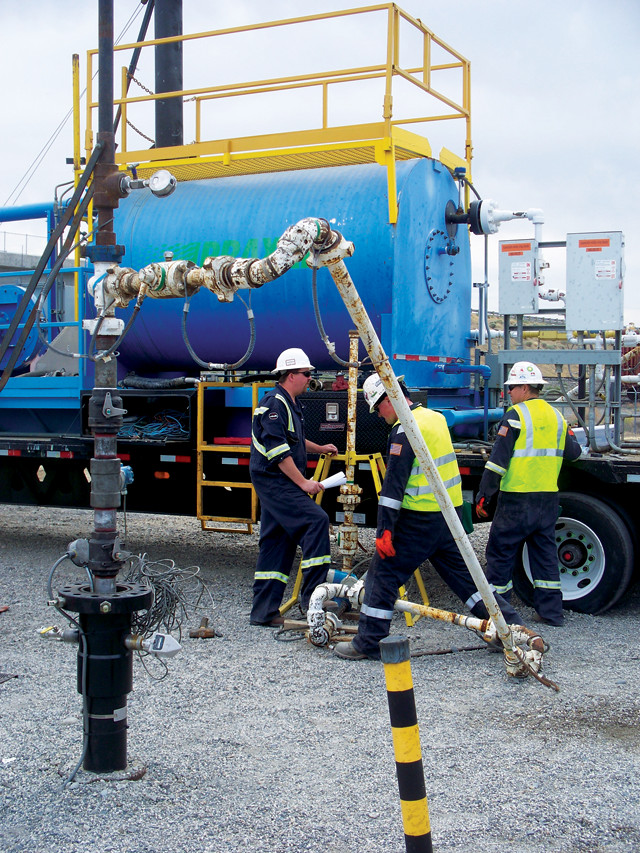
Technicians at the Wallula Basalt Pilot Project site adjust pipes carrying the carbon dioxide. The injection well is in the foreground at left. Credit: Boise Inc./Pacific Northwest National Laboratory.
During CarbFix 1, the first phase of injection tests, which ran from 2011–2012, the gases were captured at the power plant and pumped, along with water, back down an injection well and into target basalt reservoirs located at depths of 400 to 800 meters belowground. The gases are no longer buoyant once dissolved in water, and the acidic, carbon dioxide-saturated water immediately begins to attack the basalts. As the water moves through cracks and pore spaces, it leaches out calcium, magnesium and iron ions, which buffer and drive up the pH of the solution. Eventually, the dissolved carbon dioxide reaches a solubility threshold and carbonate minerals begin to precipitate. Likewise, once pumped underground, the hydrogen sulfide also reacts with the basalt to form minerals — specifically pyrite.
“It is a very simple method,” says Edda Sif Aradóttir, a chemist and CarbFix project manager at Reykjavík Energy. “This is an ongoing natural process in basalts. We are simply imitating and accelerating things that are already happening naturally.”
The original CarbFix plan actually called for injection of pure carbon dioxide following the complete separation of carbon dioxide gas from the mixed gas emissions coming from the power plant. However, the gas separation proved more challenging and expensive than anticipated, as hydrogen sulfide behaves similarly to carbon dioxide. So, after brief pilot experiments injecting pure carbon dioxide in which the researchers determined that the equipment was working, the CarbFix team shifted to co-injection of both gases, eventually injecting a total of 230 tons of carbon dioxide, 18 tons of hydrogen sulfide and approximately 7,000 tons of water during CarbFix 1 operations.

Pipes lead into the carbon injection site at Hellisheidi Power Plant. Credit: Martin Stute.
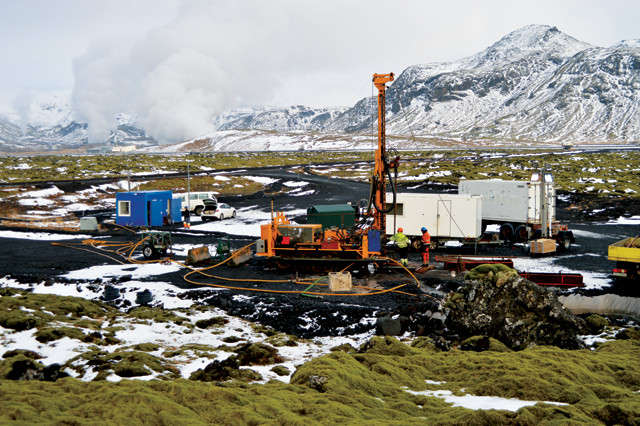
Two years after CarbFix test injections, a 150-meter core was drilled from the underground storage reservoir to look for the presence of carbonate minerals. Steam from the Hellisheidi Geothermal Power Plant is visible in the background. Credit: Juerg Matter.
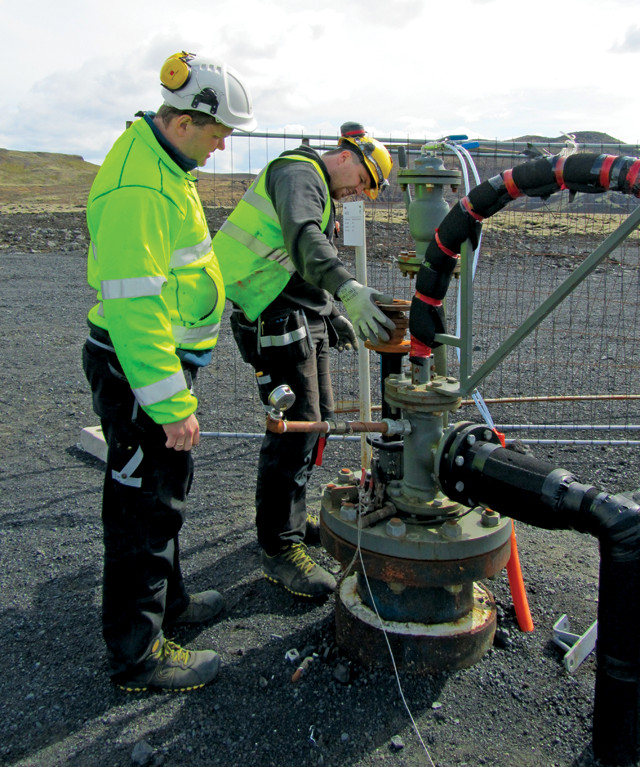
Technicians at Reykjavík Energy monitor a wellhead at the Hellisheidi Geothermal Power Plant where carbon dioxide and hydrogen sulfide are being pumped underground. Credit: Edda Sif Aradóttir.
During the CarbFix 1 test, chemical and isotopic tracers, pumped underground with the gases and water, allowed scientists to monitor the transport and reactivity of injected plumes. Monitoring wells in the basalt reservoir were used to measure pH and concentrations of dissolved inorganic carbon, and test for the presence of nonreactive, but volatile, tracers. The injected carbon dioxide was also spiked with carbon-14, which behaves similarly to carbon-12 but is largely absent from deep aquifers like the CarbFix basalt reservoir. The carbon-14 thus provided a way to accurately identify and inventory the injected carbon.
The CarbFix team was optimistic about the potential for mineralization of the injected carbon dioxide. Preliminary experiments and geochemical modeling predicted that most of the carbon dioxide would mineralize in less than 10 years. But once the gases were injected, the team was left to wait and see what would happen.
“For a while, we were seeing nothing happening in the monitoring well,” says Sigurdur Reynir Gíslason, a geochemist at the University of Iceland and head of the scientific steering committee on the CarbFix project. Then, about a year into the experiment, “we saw the tracer come through but no carbon pulse, and we realized, ‘Hey! Nothing’s happening because [the injected carbon is] all being mineralized!'”
Soon after, a malfunction with the monitoring well pump prompted the team to pull it up for unscheduled repairs. “We were not happy when the pump broke,” Aradóttir recalls, but when they pulled it up, they found — much to their delight — that it was coated with calcite. Testing proved that the calcite contained the carbon-14 tracer: It was their carbon. And calculations based on detections of dissolved inorganic carbon, tracers and carbon-14 showed that more than 95 percent of the injected carbon dioxide had mineralized underground in less than two years.
“We were thrilled,” Matter says. “We were also thrilled about the public interest and media interest,” he says. The public interest was the result of people’s desire to see some kind of positive climate change news, Aradóttir says. “This project is a bright light. People are happy to see something positive with respect to carbon dioxide emissions and climate change.” The results of CarbFix 1 were “similar to what experiments predicted, but of course you never know what will happen in the subsurface,” she says.
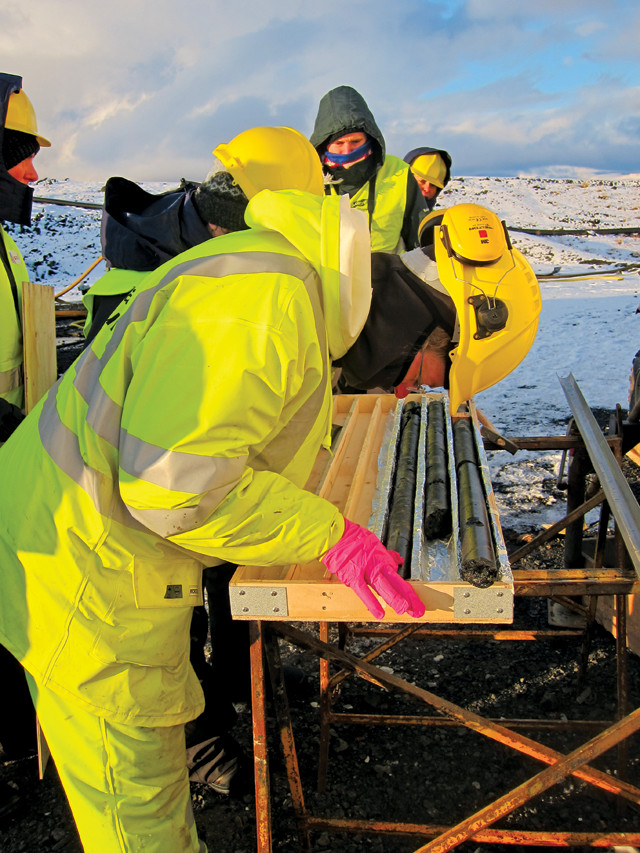
A scientist inspects a section of a core from the storage reservoir at the CarbFix site. Credit: Sigurdur Gíslason.
The hallmark of the CarbFix method is that the carbon dioxide is dissolved in the water before the injection is complete, eliminating the gas’s buoyancy. This, along with the rapid mineralization, makes the CarbFix method “rock steady,” Gíslason says. At the end of the process, he says, “you can hold the carbon in your hand.”
Once sequestered in the form of carbonate minerals, even in the event of an earthquake, carbon dioxide will not leak out of the ground back into the atmosphere, Matter says. Over geologic timescales, he notes, the carbon could eventually be rereleased via subduction zone volcanoes as the reservoir basalts are subducted along a plate boundary, but that’d only occur over millions of years. So, essentially, he says, the carbon is locked up for the long haul.
“That’s hard to beat. No other conventional storage mechanism can make a claim that it’s leak-proof,” McGrail says.
The Wallula Basalt Pilot Project in Washington achieved similar mineralization results. One thousand tons of pressurized liquid carbon dioxide was injected to a depth of nearly 890 meters belowground into the Columbia River Basalt over a three-week period in 2013. Two years later, cores were drilled from the injection zone. Small nodules found throughout the cores were identified as the carbonate mineral ankerite, and analysis showed that the carbon in the nodules was geochemically identical to that which had been injected.
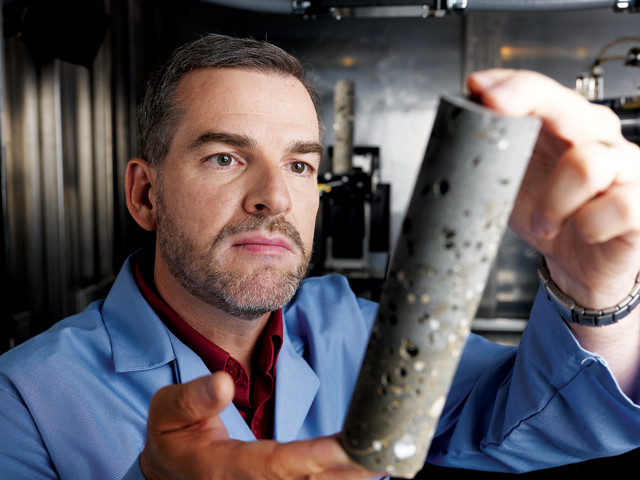
Peter McGrail, principal investigator on the Wallula Basalt Pilot Project, inspects a core section containing carbonate nodules. Credit: Pacific Northwest National Laboratory.
CarbFix 1 and the Wallula Basalt Pilot Project are both now complete. Researchers in both efforts say they hope that the projects’ success prompts further growth in CCS deployment. “The scientific community was skeptical about this method just a few years back. But now we have seen excellent results from both projects,” Aradóttir says. “There’s been interest from research institutions and industry, so I think we’ll see some more projects like ours in the near future.”
On the heels of the CarbFix 1 success, Reykjavík Energy has been scaling up its carbon dioxide and hydrogen sulfide injections at Hellisheidi since 2014 in a new round of experiments. The new phase, CarbFix 2, involves a gas separation station that collects carbon dioxide and hydrogen sulfide, new scrubbing towers that dissolve carbon dioxide into water above ground, and the use of deeper injection wells. Initial CarbFix 2 tests were encouraging, and the plant now captures and injects 10,000 tons of carbon dioxide and 6,000 tons of hydrogen sulfide a year — amounting to about a third of the carbon dioxide and two-thirds of the hydrogen sulfide emitted at the site per year. CarbFix 2 is likely to continue being scaled up, Aradóttir says. “This is part of standard operations at the plant now,” she says. “It’s very simple, it’s automatic and it’s economically viable.” Results from CarbFix 2 are expected to be published within the next year.
But as CarbFix 2 scales up, new questions and concerns have arisen, specifically about the feasibility of deploying the technology on a scale sufficient to contribute meaningfully to the global greenhouse gas emissions reductions required to keep climate change in check.
Among these concerns is the risk of clogging the basalt reservoirs. “There is no question that we are clogging up the flow paths” within the rock, Gíslason says. The minerals that precipitate during this process have a greater molar volume than those that were initially dissolved, he says. This, along with the added mass of the carbon dioxide and hydrogen sulfide, could potentially fill up the reservoir void space over time.
But that shouldn’t be a problem so long as mineralization doesn’t plug the injection sites, forcing the costly re-drilling of wells, Gíslason says. Fortunately, “the method creates porosity around the injection well because the low pH of the injected water keeps most minerals undersaturated and unable to precipitate until they move farther away from the injection site.” Gíslason says that the high pressure from the injection process itself can also create micro-fractures in the subsurface — similar to a small-scale version of hydraulic fracturing — which helps slow reservoir clogging by exposing fresh basalt and new cracks where the injected carbon dioxide mixture can flow and mineralize. CarbFix researchers are optimistic; they have been injecting into the same well for nearly three years with no clogging issues. “We’re beginning to explore how we would carry out injections long-term,” Aradóttir says, “but we don’t expect clogging to happen suddenly.”
A second concern is the high water use required by the CarbFix method. About 25 tons of water is needed per ton of carbon dioxide injected; only about 5 percent of the injected mass in the CarbFix method is actually carbon dioxide.
But water demands have so far not been a barrier for the CarbFix project because the geothermal plant already pumps and injects high volumes of water during the power generation process and, according to Gíslason, the water can be recycled by extracting and reinjecting it multiples times.
Water was not a concern in Washington, either. Because of the cap rocks present at the Wallula Basalt Pilot Project site, researchers were able to inject pressurized liquid carbon dioxide without having to dissolve it in water first — a method that, according to McGrail, uses 100 times less fluid than the CarbFix way.
Gíslason acknowledges that water limitations will be a significant challenge to other projects that may seek to store carbon dioxide in fractured basalt. But sources other than groundwater, including seawater and even wastewater, could also potentially be used, he says. “If we are going to do this type of carbon injection on a large scale, that’s the direction we have to go.”
Groundwater contamination because of high-volume carbon dioxide injections is also a potential concern that CarbFix researchers are studying. Lab and field studies so far indicate that there’s little risk. “A nice side effect of the reactions that are happening in the basalt is that you co-precipitate other metals, like heavy metals, within the carbonates,” Aradóttir says. “You can end up with purer water than you injected.” The potential to purify water could be an appealing spin-off opportunity, Gíslason adds. Recirculating the water — injecting what was initially pumped up from the reservoir — can also help limit larger-scale hydro-fracturing concerns, he says, as water pressure in the reservoir will not exceed what had naturally occurred.
Another feasibility factor at other sites is that basalts are heterogeneous, McGrail says. Scientists have to determine: “Do we have consistent permeability in the basalt formation at the kind of scales that a commercial project would require?” he says.
There is no shortage of potential sites with basalt reservoirs that could host CCS operations: everywhere from massive flood basalts like the Deccan Traps in India, the Columbia River basalts in the U.S. Pacific Northwest, and the Siberian Traps in Russia, to smaller basalt fields in Saudi Arabia, Somalia, Australia, Japan and parts of the U.S. Prior to injection, researchers would need to determine the specifics of the local basalt geology, tectonic history and regional water availability to see what type of carbon dioxide injection would be most effective. Mid-ocean ridges are also an option, depending on a number of factors, not the least of which is transporting the carbon dioxide there, Gíslason says. Scientists, including David Goldberg, a geophysicist at Lamont-Doherty Earth Observatory, are actively exploring this offshore potential. “Iceland was a key demonstration,” Goldberg said in a statement about his research, “but the Holy Grail is offshore.”
With widespread availability of basalts, and a clear need for growth in CCS deployment (if international goals for greenhouse gas emissions reduction are to be met), what is required to expand the use of this technology?
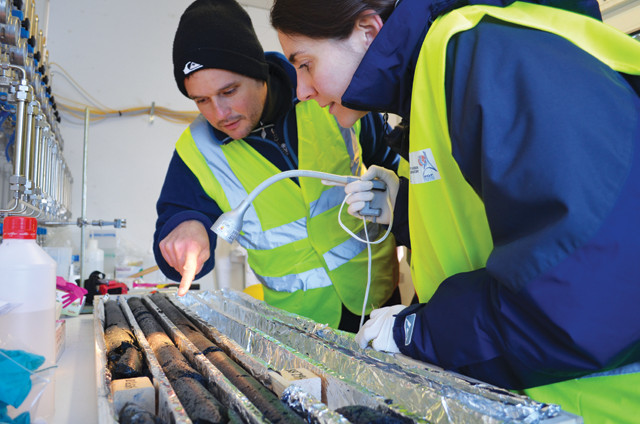
Juerg Matter (left) and Rosalia Trias (right), a microbiologist at the Paris Institute of Earth Physics, inspect a freshly retrieved core from the CarbFix site. Credit: Kevin Krajick, Columbia University.
Cost is one of the biggest challenges, Reiner says. The Global Carbon Capture and Storage Institute estimates that it costs between $60 and $130 to capture and store a ton of carbon dioxide. The bulk of this cost comes during the gas capture portion of operations. Injecting gas mixtures, as done at CarbFix, helps lower the cost by avoiding expensive gas separation methods. “We need to look at other settings that create dirty gas such as coal-fired power plants,” Gíslason says. “[Gas capture] is where we need technological innovations,” as these will help to further drive costs down.
At CarbFix, hydrogen sulfide mitigation is driving the upscaling process forward. The co-injection proved to be “a way to get rid of sulfur-bearing gases in a much cheaper way than normal,” Aradóttir says. “It’s a great added benefit.” Preliminary financial results from CarbFix 2 operations are promising. “Considered over the lifetime of the power plant, it costs less than $30 to store a ton of carbon dioxide,” she says. This is within striking distance of historical European Union emissions trading scheme carbon prices, which were nearly $25 in 2011 (the price of carbon is now quite low at less than $8 per ton). If the price of carbon returns to its previous levels, EU industries will have a financial incentive to pursue CCS rather than pay for their emissions, Gíslason says. Because it’s safely locked underground, “CarbFix has solved the safety aspect,” he says, “and now it’s tackling the price question.”
Projects like CarbFix and the Wallula Basalt Pilot Project put us on a technology pathway where we may start to see some of those costs coming down, Reiner says. “We’re tackling the technology questions, but until we significantly scale up, we’re not solving the climate problem,” he says. “It’s incredibly important for these first projects to happen if we ever want to get up to project three, four and five; or, if we are serious about climate change, projects 30, 300 and 3,000.”
© 2008-2021. All rights reserved. Any copying, redistribution or retransmission of any of the contents of this service without the expressed written permission of the American Geosciences Institute is expressly prohibited. Click here for all copyright requests.